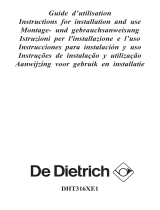
IMPORTANT; BEFORE ANY OPERATION OF INSTALLATION AND USE, TAKE NOTE OF THE
FOLLOWING INSTRUCTIONS:
The distance between the supporting surface for the cooking vessels on the hob and the lower part of the hood must be at least 65
cm. If the instructions for installation for the hob specify a greater distance, this has to be taken into account.
The air collected must not be conveyed into a duct used to blow off smokes from appliances fed with an energy other than electricity
(central heating systems, thermosiphons, water-heaters, etc.).
Comply with the official instructions provided by the competent authorities in merit when installing the disposal duct. In addition,
exhaust air should not be discharged into a wall cavity, unless the cavity is designed for that purpose.
The room must be well aerated in case a hood and some other heat equipment fed with an energy other than electricity (gas, oil,
coal heaters, etc) operate at the same time.
In fact the intake hood, disposing of air, could create a vacuum in the room. The vacuum should not exceed 0,04mbar. This prevents
the gas exhausted by the heat source from being intaken again. It is therefore advisable to ensure the room contains air taps able
to ensure a steady flow of fresh air.
Check the data label inside the appliance; if the symbol (
) is printed, read the following: this appliance has such technical
particulars that it belongs to class II insulation, therefore it must not be earthed.
The following warning is valid in the United Kingdom only: in case your cable is not furnished with a plug, read the following
instructions; as the colours of the wires in the mains lead of this appliance may not correspond with the coloured markings identifying
the terminals in your plug, proceed as follows: – the wire which is coloured blue must be connected to the terminal which is marked
with the letter N or coloured black; – the wire which is coloured brown must be connected to the terminal which is marked with the
letter L or coloured red. – terminal of a three-pin plug.
Check the data label inside the appliance; if the symbol (
) is NOT printed, read the following: ATTENTION: This appliance must
be earthed. When making the electrical connections, check that the current socket has a ground connection.
The following warning is valid in the United Kingdom only: in case your cable is not furnished with a plug, read the following
instructions; as the colours of the wires in the mains lead of this appliance may not correspond with the coloured markings identifying
the terminals in your plug, proceed as follows: – the wire which is coloured green and yellow must be connected to the terminal in
the plug which is marked with the letter E or by the earth symbol [
], or coloured green or green and yellow; – the wire which is
coloured blue must be connected to the terminal which is marked with the letter N or coloured black; – the wire which is coloured
brown must be connected to the terminal which is marked with the letter L or coloured red.
When making the electrical connections, check that the voltage values correspond to those indicated on the data plate inside the
appliance itself. In case your appliance is not furnished with a non separating flexible cable and has no plug, or has not got any other
device ensuring omnipolar disconnection from the electricity main, with a contact opening distance of at least 3 mm, such separating
device ensuring disconnection from the main must be included in the fixed installation. If your unit features a power lead and plug,
position this so the plug is accessible.
Always switch off the electricity supply before carrying out any cleaning or servicing operations on the appliance.
ATTENTION: This appliance must be grounded.
USE
Avoid using materials which could cause spurts of flame (flambées) near the appliance.
When frying, take particular care to prevent oil and grease from catching fire. Already used oil is especially dangerous in this respect.
Do not use uncovered electric grates.
To avoid possible risks of fire always comply with the indicated instructions when cleaning anti-grease filters and when removing
grease deposits from the appliance.
MAINTENANCE
Thorough servicing guarantees correct and long-lasting operation.
Any fat deposits should be removed from the appliance periodically depending on amount of use (at least every 2 months). Avoid
using abrasive or corrosive products. To clean painted appliances on the outside, use a cloth dipped in lukewarm water and neutral
detergent. To clean steel, copper or brass appliances on the outside, it is always best to use specific products, following the
instructions on the products themselves. To clean the inside of the appliance, use a cloth (or brush) dipped in denatured ethyl
alcohol.
ENGLISH







